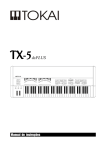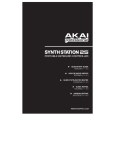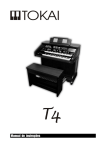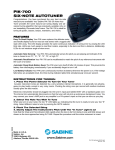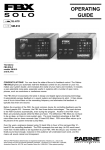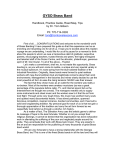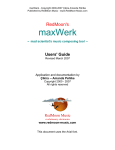Download SABINE STX-1100 Specifications
Transcript
STX-1100 STX-1500 & CHROMATIC AUTO TUNERS 13301 Highway 441, Alachua, FL 32615-8544 USA www.SabineUSA.com BRIEF HISTORY Sabine introduced its first tuner in the summer of 1988: the Sabine ST-1000 Chromatic AutoTuner. The ST-1000 incorporated a fully custom integrated circuit that combined numerous electronic parts into a single component. Its unique electronics made tuning easier and more accurate than ever before. In only one year, the ST-1000 became the best selling chromatic tuner in the United States. Now Sabine is proud to offer the STX-1100 and STX-1500 AutoTuners–the next generation in high quality tuners. ALL NEW TECHNOLOGY The Sabine STX-1100 and STX-1500 Chromatic AutoTuners use an entirely new tuning technology that provides superior performance. While both new tuners still provide essentially all of the features of the ST-1000, these new tuners have an expanded range to accommodate the low B of a five-string bass guitar, and they display the tuning error quicker, making tuning even easier. Both new tuners automatically turn themselves off after 15 minutes of quiet to extend the battery life, and they both have 9 Volt DC adaptor jacks. Additionally, the STX-1500 has three outstanding features: It has a built-in tone generator for an audible reference tone; it can be recalibrated both automatically and also manually to any of 12 precise frequencies; it can be transposed to any key. 2 STX-1500 Music Stand Clips (Recalibrate -1100) (Function - 1500) On/Off Switch 9-volt Adapter Jack Instrument Jack Fine Tune Row IN ST RU M EN T Amplifier Jack Function Scale Note Indicator Row Microphone (1500 ONLY) 3 OUTSTANDING FEATURES OF YOUR SABINE AUTOTUNER CHROMATIC SCALE - FULL RANGE The STX-1100 and STX-1500 automatically sense all 12 notes in the musical scale. They tune all open strings, from the fivestring bass to the mandolin and violin, and they can be used to tune all musical instruments and voice. AUTOMATIC NOTE SENSING The STX-1100 and STX-1500 both automatically determine and display which musical note is being played. The hands-free operation of these tuners allows the musician to monitor the pitch while playing. AUTOMATIC RECALIBRATION Both Sabine AutoTuners can be recalibrated to match the pitch of any reference instrument with the touch of a button. AUTOMATIC SLEEP MODE BATTERY SAVER If there is no tone for 15 minutes, the tuner will turn itself off automatically. 4 EASY-TO-READ DISPLAY The STX-1100 and STX-1500 replace the delicate meter and needle display with a rugged solid-state LED array. The LED display provides the same continuous indication of tuning error by varying the LED blink rate. But LEDs are much easier to read, especially in the dark or at a distance. Additionally, LEDs do not introduce angle-of-view errors. QUARTZ ACCURACY A highly stable quartz crystal resonator assures that the Sabine AutoTuner is much more accurate than the human ear (+/- one cent.) MUSIC STAND AND AMPLIFIER MOUNTS The STX-1100 and STX-1500 have two stainless steel clips built into the case top so the tuners can be easily mounted on a music stand. Also included are two reusable cable ties for mounting the tuner to an amplifier. 9 VOLT DC ADAPTOR Any standard 9 Volt DC adaptor can be used with the STX-1100 and STX-1500. If the adaptor has a polarity switch, set the center pin of the DC adaptor jack to negative. 5 FEATURES FOUND ONLY ON THE STX-1500 AUTOTUNER MANUAL RECALIBRATE The SXT-1500 can be recalibrated to any of 12 precise frequencies–many more than available on other tuners. TONE GENERATOR The STX-1500 will generate a reference tone through an amplifier for tuning by ear. TRANPOSES TO ANY KEY The STX-1500 can be transposed to any key–a special advantage for many band and orchestra musicians. INSTRUCTIONS FOR TUNING 1. SLIDE THE ON/OFF SWITCH TO ON. Wait two seconds for the green light to start blinking. The green light will blink once per second to indicate that the unit is on and ready. Acoustic instrument tones are detected by a very sensitive internal microphone. It is generally not advantageous to play loudly, except in very noisy rooms. Medium loudness usually gives the best results. Electronic instruments should be connected with a standard cord with a 1/4" phone jack to the input labeled INSTRUMENT. The 6 internal mic is automatically disconnected when an electronic instrument is connected so that the tuner will not pick up extraneous room noise. You may connect the tuner’s AMPLIFIER jack to any amplifier’s or P.A. system’s input so that you can tune as you play. 2. PLAY A SINGLE TONE THAT YOU WISH TO TUNE. Adjust the instrument’s pitch until the desired NOTE INDICATOR light is lit. For example, if you wish to tune a D string on a guitar, pluck the string and tune it until the “D” note indicator light is lit. Pluck the string every second or so to keep the note “fresh” and to prevent the note from fading flat. 3. SLOWLY ADJUST THE INSTRUMENT’S PITCH UNTIL THE GREEN “IN TUNE” LIGHT IS LIT. Note that the SHARP and FLAT indicators blink rapidly when the tone is far from being in tune and blink slower and slower as the tone approaches being IN TUNE. Repeat steps 2 and 3 for the other notes until the entire instrument is tuned. Note: The STX-1100 and STX-1500 have new contrasting red and green note indicator LEDs. The green LEDs indicate the six standard guitar notes (E,A,D,G,B,E). 7 HOW TO USE THE SPECIAL FEATURES AUTOMATIC BATTERY MONITORING Both the STX-1100 and STX-1500 monitor the voltage of their batteries automatically. If the voltage gets low, the "In Tune" indicator light (green) will stop blinking and the "Flat" (amber) and "Sharp" (red) indicator lights will blink simultaneously. The tuner will then tune accurately for about 10 more hours. AUTOMATIC SLEEP MODE BATTERY SAVER Both tuners will turn themselves off if they do not hear a tone for 15 minutes to help prevent the battery from discharging unnecessarily. To turn the tuner back on from sleep mode, simply move the power switch to OFF and then back ON. Note: A very small amount of current will be drawn from the battery in sleep mode, so it is best to turn the tuner off with the power switch. 9 VOLT DC ADAPTOR Any standard 9 Volt DC adaptor can be used with the STX-1100 and STX-1500. If the adaptor has a polarity switch, set the center pin of the DC adaptor jack to negative. MUSIC STAND CLIPS The STX-1100 and STX-1500 mount easily to the bed of a music stand so that you can monitor your pitch while you play. (See Figure 1.) If your stand has a sharp or ragged edge, a strip of tape along the edge will prevent scratching the top of your tuner. 8 The clips will easily accommodate a thin piece of metal like a music stand, but they will be permanently bent if you try to jam them over something thicker, such as the handle of a guitar amp. (See Figure 1.) BENT CLIPS ARE NOT COVERED UNDER WARRANTY. Figure 1 AUTOMATIC RECALIBRATION Most tuners on the market will allow the user to recalibrate only a few Hertz from standard A=440Hz. They prove to be almost useless if the user wishes to tune to an instrument that is more than a few Hertz out of tune. However, both the STX-1100 and STX-1500 can be recalibrated to match any instrument by simply touching a button. 9 Example: If you wish to tune a guitar so that it will be in tune with a certain piano, simply play any note on the piano, and wait a moment for the note to register on the tuner’s display. Then touch the calibrate (or FUNCTION) button on the tuner. Instantly the green IN-TUNE light will go on, indicating that the tuner now considers the piano to be in perfect tune. Now if you tune your instrument to the tuner, your instrument will be in tune with the piano. To return the tuner to standard A=440Hz., simply move the power switch to OFF and then back ON. The tuner always resets its internal scale to A=440Hz. when it is turned on. MANUAL RECALIBRATE Most other tuners on the market allow the user to manually recalibrate to a very limited number of pitches. However, the STX-1500 can be recalibrated to any of 12 precise pitches. This feature will be especially useful for tuning instruments that use open tunings, such as banjos, dulcimers, Irish harps, pedal-steel and bottle-neck guitars, etc., or any time you may wish to tune to a “natural scale” rather than an “even-tempered scale.” Example: If you wish to recalibrate the tuner from standard A=440Hz. to A=438Hz., press the FUNCTION button and hold until the top row of LEDs (MANUAL/FLAT, TONE OUT/IN TUNE and TRANSPOSE/SHARP) light in sequence. Release the FUNCTION button when only the (MANUAL) LED is lit. The bottom row of LEDs will begin to light in sequence. (Each LED represents 1 Hertz.) Press the FUNCTION button when the LED corresponding to 438Hz. lights. The tuner’s scale is now shifted flat from 10 A=440Hz. to A=438Hz. Please note the manual recalibration scale is referenced in Hertz and in ¢. (There are 100¢ between any two adjacent notes in the musical scale, and one Hertz is equal to one vibration per second.) To return the tuner to standard A=440Hz., simply turn the power switch to OFF and then back ON. TONE GENERATOR The STX-1500 will generate any reference tone over a twooctave range so that you may tune by ear. Example: First, plug the tuner into an amplifier. If you wish to hear a “C” note, press the FUNCTION button for three seconds until the MANUAL/FLAT, TONE OUT/IN TUNE and TRANSPOSE/ SHARP LEDs light in sequence. Press the FUNCTION button when the TONE OUT LED is lit. Now the “A” LED on the bottom will light and an “A” will sound through the amplifier. Each time you press the FUNCTION button, the pitch will raise one-half tone. Press the FUNCTION button three times to generate a “C” note. You may stop the tone generator simply by turning the tuner OFF and back ON. You may play your electric instrument through the tuner while in TONE mode. You will hear your instrument and the reference pitch at the same time so that you can match the tones precisely. The volume control on your instrument will act as the volume control of the tone generator also. 11 TRANSPOSE The STX-1500 can be transposed to any key. This is especially useful if you are using a fretted instrument with a capo or if your instrument is not tuned in the key of “C,” such as a B-Flat trumpet or E-Flat alto sax. Example: If you wish to transpose the tuner for use with a “BFlat” trumpet, press the FUNCTION button and hold until the top row of LEDs (MANUAL/FLAT, TONE OUT/IN TUNE, TRANSPOSE/SHARP) light in sequence. Release the FUNCTION button when the (TRANSPOSE/SHARP) LED is lit. The twelve note indicator LEDs will now light in sequence. Press the FUNCTION button when “A#” (which is the same as B-Flat) lights. The tuner’s internal scale is now shifted down one full tone, which allows “C” played on the B-Flat trumpet to register “C” on the tuner, not “B-Flat” as before transposing. To return to standard “C” tuning, turn the unit OFF and then back ON. TUNING TIPS Most musical instruments have peculiarities that can cause annoying tuning problems. Fortunately, most of these peculiarities can be overcome by following these simple procedures: FRETTED INSTRUMENTS 1. PLUCK THE INSTRUMENT ONCE PER SECOND AT NORMAL VOLUME WHILE YOU ARE TUNING. Plucked strings go noticeably flat a few seconds after they have been plucked. 12 2. TUNE STRINGED INSTRUMENTS FROM A PITCH THAT IS FLAT UP TO THE PITCH YOU DESIRE. This procedure removes any slack in the gears of the instrument’s tuning heads. If you tune from SHARP to IN TUNE, the gears will slip as you play and the instrument will go flat. 3. IF YOU HAVE DIFFICULTY GETTING A NOTE TO REGISTER ON THE TUNER, TRY TOUCHING THE OTHER STRINGS LIGHTLY TO STOP THEIR VIBRATIONS. This will eliminate any extraneous overtones that may disturb the tuning. 4. USE GOOD STRINGS. Old strings tend to lose their uniformity and will not vibrate evenly. Brand new strings stretch flat as you play. 5. ALL SOURCES OF FRICTION WILL CAUSE PROBLEMS. For example, if the slot in an instrument’s nut is too tight, the string will be pulled flat as it is played. A tight nut (or capo) will cause the string’s pitch to change in steps rather than evenly. 6. AVOID PRESSURE ON THE INSTRUMENT WHILE TUNING. Even moderate pressure on the neck of a guitar will cause a noticeable change in pitch. Also, press the strings straight down to the fingerboard. Bending the strings sideways is very common, especially on difficult chords, but causes the strings to be pulled sharp. 13 7. A NOTE FOR ADVANCED FRETTED INSTRUMENTALISTS. All fretted instruments, and most other instruments, are constructed to play an “even-tempered scale.” Sabine tuners are also calibrated to this scale. The “even-tempered scale” places equal tonal spacing between all notes in the scale so that the musician will not have to retune to change keys. A disadvantage, however, is that the third note of the scale sounds a little sharp (14 cents, to be exact). For example, when playing in the key of G, the B will sound sharp. If you tune the B string so that it sounds correct in an open G chord, other chords using the B string will sound out of tune. The musician may choose to optimize the tuning for a particular key or to use the “eventempered scale.” Much depends on the musician’s style, but generally it is best to tune exactly as your Sabine tuner indicates. WIND INSTRUMENTS, VOICE AND INSTRUMENTS OF THE VIOLIN FAMILY: Sabine tuners are excellent teaching aids for both beginning and advanced musicians. During practice, the musician should clip the Sabine AutoTuner to a music stand as illustrated in the drawing. Practice playing long, steady tones and intervals. Try to keep the green IN TUNE light lit. Standing with good posture will facilitate good breath and hand control. The visual feedback from the tuner will greatly reduce the time needed to train your ear to play or sing beautifully and in tune. 14 SPECIFICATIONS Size: 3-3/4 x 3-3/4 x 1-3/8 inches Weight: 6 oz Battery: 9 Volt standard or alkaline Scale: Even Tempered, 12 notes per octave Range: Tunes all open strings, from the five-string bass to the mandolin and violin Accuracy: +/- 1 cent (uses quartz crystal) Accessories, Included: Battery, Cable Ties Accessories, Optional: CM-1 Contact Mike, 9 Volt DC Adaptor CONTACT MICROPHONE (OPTIONAL) The Sabine CM-1 contact microphone makes tuning an acoustic instrument as easy as tuning an electric guitar. It has a removable rubber suction cup to stick the mic directly onto the instrument. The CM-1 is ideal for tuning an acoustic guitar in a noisy room or for tuning instruments that have very short tones like banjos or mandolins. Ask your dealer or send $20.95 to Sabine. (U.S. or Canada only. Send $27.95 in other countries.) The CM-1 comes with a 30-day money back guarantee. 15 LIMITED WARRANTY If your STX-1100 or STX-1500 tuner fails because of a manufacturing defect within TWO YEARS from the date of original purchase, please return, postage prepaid, to SABINE for a replacement with a new or reconditioned product. This warranty does not cover damage caused by accident, misuse, or defective batteries. You must include your full name, address, proof of purchase and the nature of the defect. DAMAGE CAUSED BY BENDING THE MUSIC STAND CLIPS IS NOT COVERED UNDER WARRANTY. This warranty is in lieu of all other warranties, expressed or implied. This warranty gives you specific legal rights which vary from state to state. Applicable in the USA and Canada only. 13301 Highway 441, Alachua, FL 32615-8544 USA Phone: (904) 418-2000 FAX: (904) 418-2001 www.SabineUSA.com © 1999 Sabine, Inc. MADE IN THE USA STX-OpGd-9910 991020-hto

















